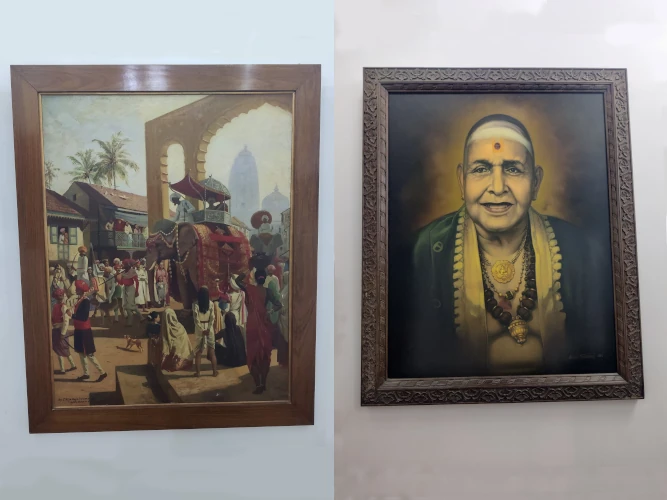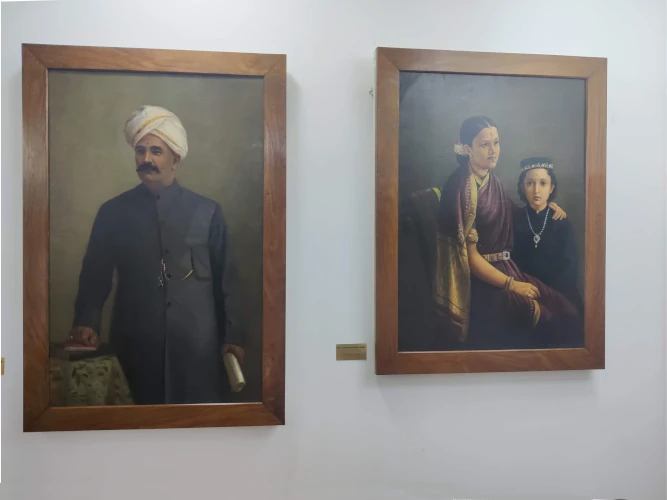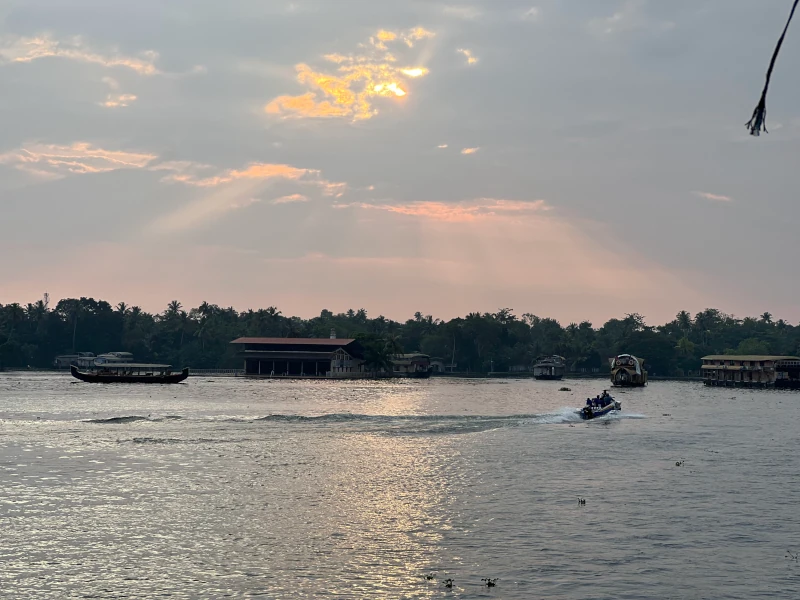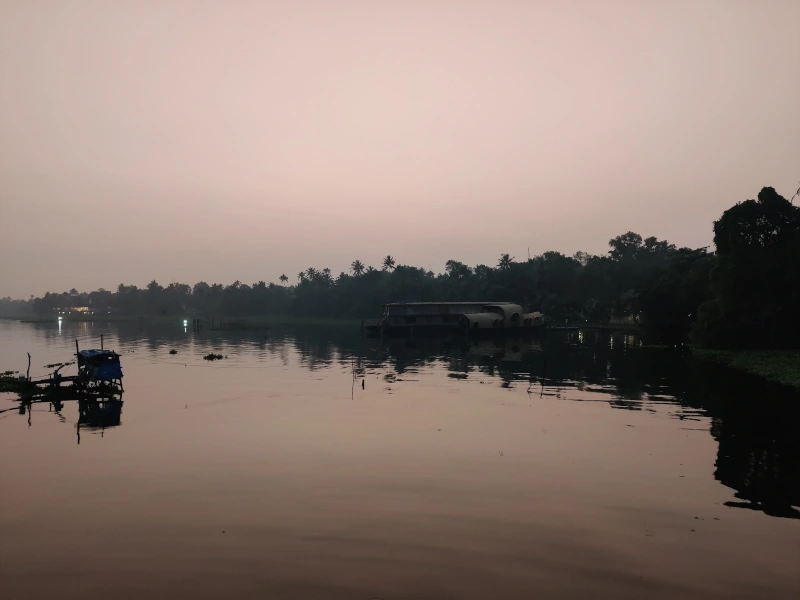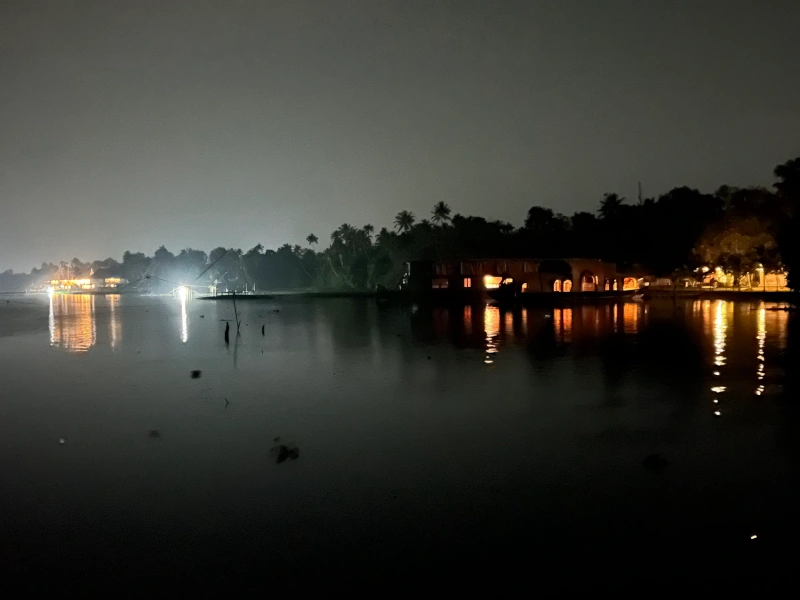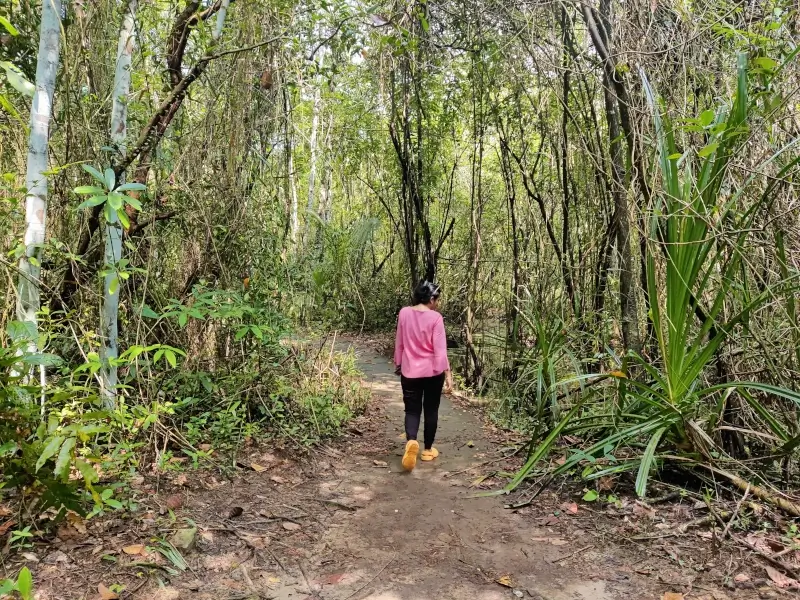Kerala - God’s Own Country
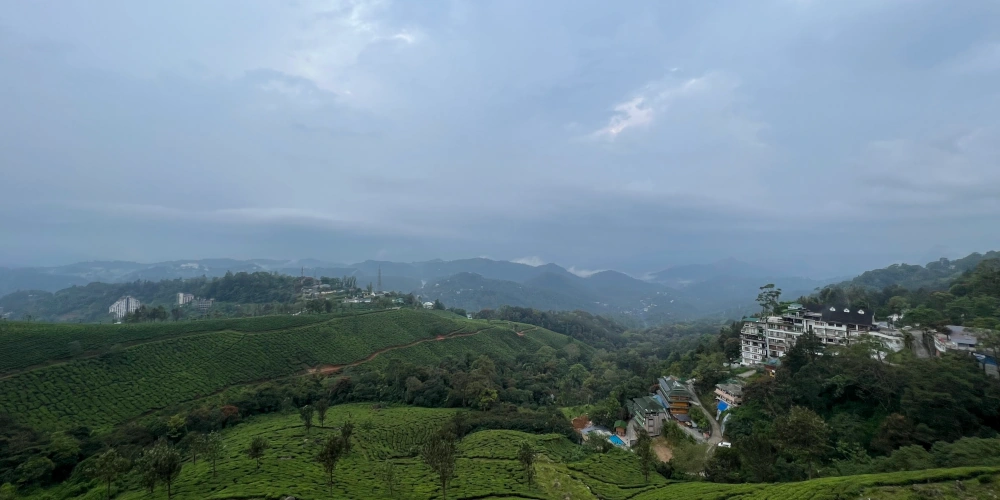
Kerala is the picturesque beauty that is located in the tropical Malabar Coast of India. It is famous for its hill stations, lush green escapades, pristine beaches, rich and diverse cultural heritage and serene backwaters.
According to Hindu mythology, Kerala was created by Lord Parasurama, an incarnation of Lord Vishnu by throwing his axe across the sea to create new land for his devotees to live peacefully. So, Kerala is God’s own creation, hence it is called God’s own country.
It has been one of the places that have been in my bucket list for too long. I had the whole trip planned back in 2018, but sadly enough, kerala suffered one of its worst flood that year.
This is just my personal travel log which I write so that few years down the line I remember it as vividly as I do it right now. For tips and other stuff please follow professional bloggers. All the images/videos are clicked by me.
Our Journey
To reach Kerala, we took a flight to capital city i.e Trivandrum. Then we went to Kovalam (town in Trivandrum district) by car since our stay was near Kovalam beach.
After visiting nearby places in Trivandrum we went to Poovar island. Since we had never visited Kanyakumari and being just 3hrs away we decided to go to southern most point of India. After that we stayed the night in Kovalam and went to Alleppey next day. After spending fantastic time on houseboat we went from hot and humid heat to pleasant and temperate climate in Munnar.
Trivandrum
Trivandrum is the capital city of Kerala and is one of the largest cities in the state. It is rich in culture, historic landmarks and natural beauty. The city is surrounded by stunning beaches, backwaters, lush green hills and forests. You can also find lot of restaurants offering kerala's authentic cuisines. Apart from this Thiruvananthapuram is the official seat of Travancore royal family. Although they don't have any political power they do own lot of land and properties in the city.
Sree Padmanabhaswamy Temple
Sree Padmanabhaswamy Temple is dedicated to Lord Vishnu who is enshrined in the "Anantha Shayana" posture, the eternal yogic sleep on the infinite serpent Adi Shesha [also called Sheshnaga]. The temple is so famous that the city is named after it. The Malayalam translation of Thiruvananthapuram means "The City of Lord Ananta" where Ananta is a form of Lord Vishnu.
The temple is said to be an architectural marvel. The temple has two parts, outer temple and inner temple. In the dawn or evening the outer temple shines from the sunlight glinting off the gold coating. It is the richest temple in the world. According to sources1 there are 6 vaults filled with gold crowns, diamonds, coins, statues, and other precious gems. Rumor has it that not all of it have been opened.
-
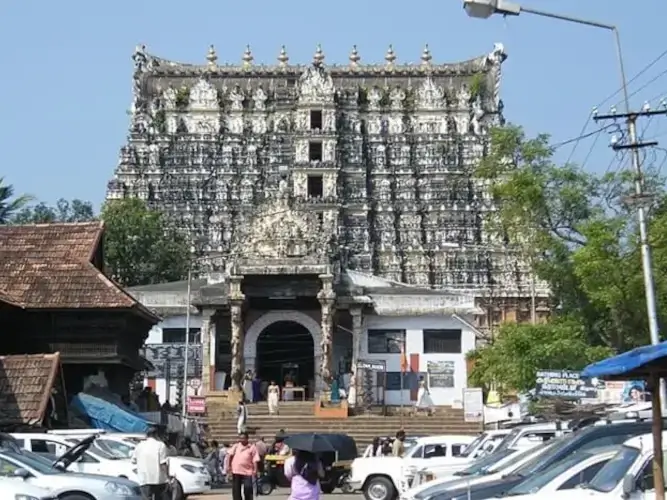 Outside of Sree Padmanabhaswamy Temple
Outside of Sree Padmanabhaswamy Temple
The temple have strict dress code for both males and females. Men have to wear dhoti with or without Angavastra and females can wear any traditional dress such has saree, dhotis, etc. I had to change since I was wearing jeans. Also wearing nothing on the top was not exactly pleasant, especially in the crowd inside the main temple. Anyways it was an experience.
Thiruvananthapuram Zoo
Thiruvananthapuram Zoo is one of the oldest zoos in India. It contains over 82 different species of mammals, birds and reptiles. Honestly speaking I never expected to see much but I saw, Lion, White Tiger, Leopard, Rhinoceros, Hippopotamus, Variety of deers, etc in mammals. In reptiles section you can see Anaconda, Python, King Cobra, Ghariyal, and much more. Some of the exotic birds from Australia such as Ostrich, Emu, Stork can also be seen. It was my first time seeing such a wide variety of exotic animals, and believe me I have been to lots of zoos and wild life sanctuaries.
-
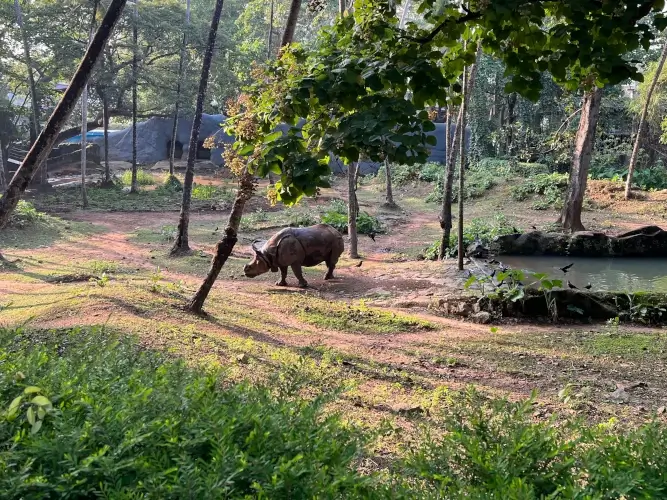 Rhinoceros Basking In the Sun
Rhinoceros Basking In the Sun -
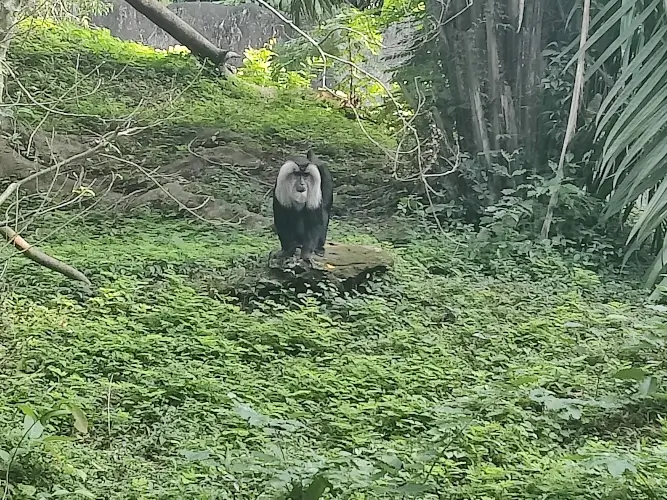 Rhesus Monkey
Rhesus Monkey -
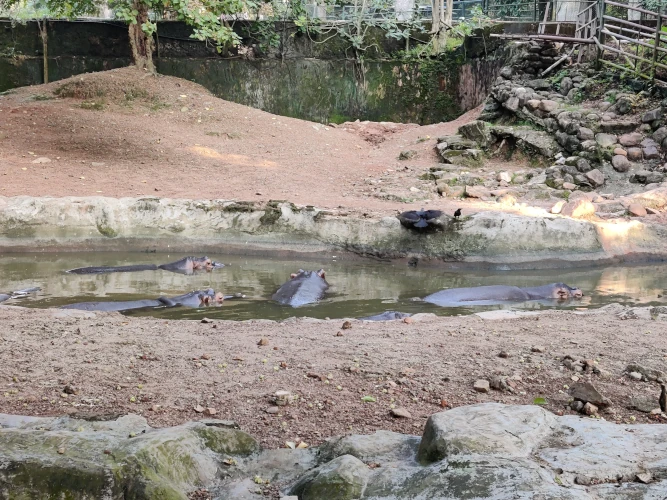 Hippopotamus taking a dip
Hippopotamus taking a dip -
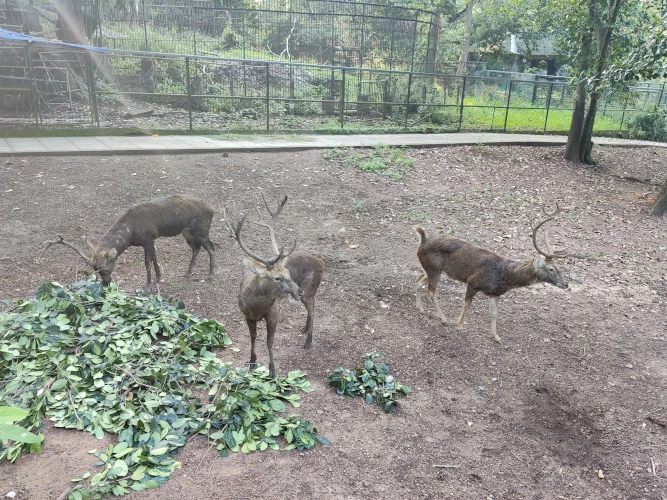 Barah Singha
Barah Singha -
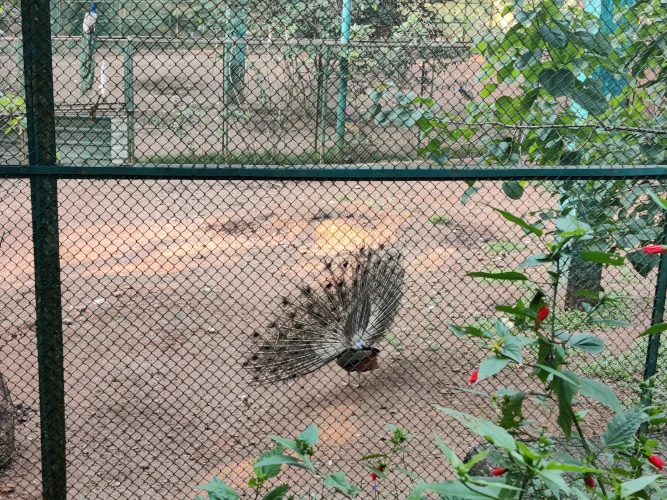 Dancing Peacock
Dancing Peacock -
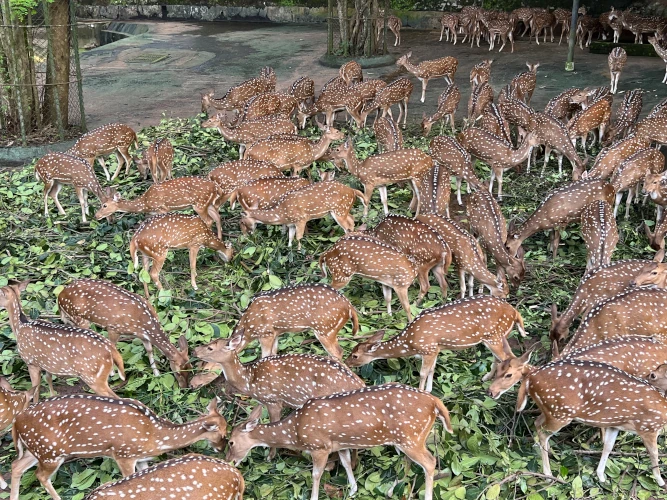 Herd of Deers
Herd of Deers
The walking distance in the zoo was long [approx 6kms] but pleasant weather with natural greenery made this a really nice trek.
Sri Chitra Art Gallery
This art gallery is quite old. It was established in 1935 by Chithira Thirunal Balarama Varma, the last Maharaja of the Princely State of Travancore. The gallery contains lots of famous works of Raja Ravi Verma, commonly known as “The Father of Modern Indian Art,” - a very well-known painter of the 18th century. It also contains Indian mural paintings, miniatures from different parts of the world, reproductions of murals of Ajanta, Bagh, Sigiriya, and Sittannavasal, and manuscripts of archival importance.
Even though I don't understand art, but it was nice to see 18th century lifestyle depictions. There were also some scenes from sacred texts like Shakuntala, Damayanti Talking to a Swan, etc.
Well that concluded our first day of the trip. We went back to our hotel, enjoyed little at the beach and then turned in for the night.
Poovar Island
Poovar is a small village with golden sand beaches, picturesque backwaters and sits between the Neyyar River and the Arabian Sea. It is one of the ancient Muslim settlements and was a trading centre of timber, sandalwood, ivory and spices being so close to the sea port.
The boat ride took us through the mangroves, coconut groves, and golden beaches of Arabian Sea. The island's location is truly remarkable, river on one side and sea on other. During the ride we encountered several birds [I was only able to identify crane]. Among the trees we saw coconuts, mangroves, and suicide tree. According to our ferryman, the fruits of suicide tree have a long tradition of being used for murder in this region.
-
Backwater Ride
-
Timelapse through the ride
-
 We saw a crane
We saw a crane -
 Poovar Island Resort
Poovar Island Resort -
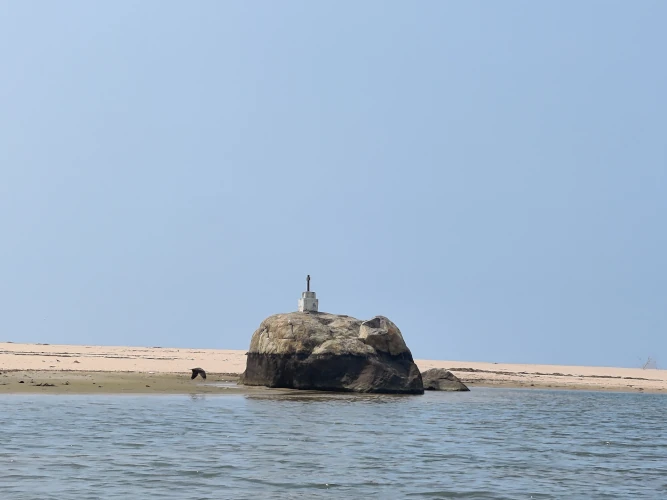 Poovar Beach - Neyyar River Meets Arabian Sea
Poovar Beach - Neyyar River Meets Arabian Sea -
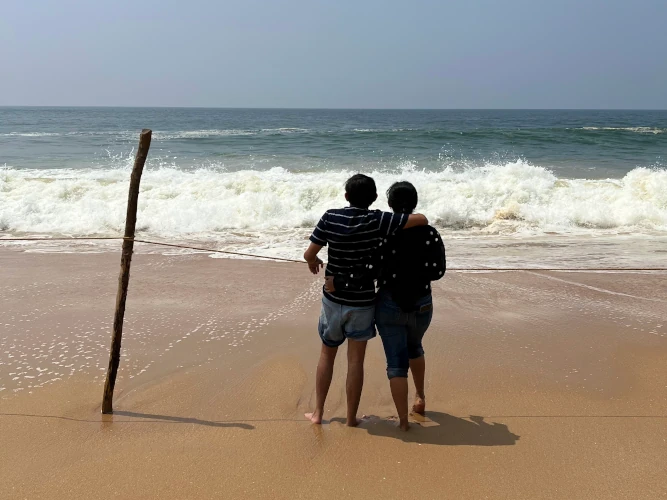 Enjoying the waves of Arabian Sea
Enjoying the waves of Arabian Sea
The birds chirping, the sound of the water, and the gentle breeze made it a truly memorable experience.
Exploring our Hotel - Uday Samudra
The hotel is located right on the beach, and as soon as we arrived, I was struck by its grandeur and the beautiful view of the Arabian Sea. As we were escorted to our room, I couldn't help but notice the beautiful architecture and the lush greenery surrounding the hotel.
One of the highlights of our stay was the food. The hotel has multiple restaurants, and each one had a unique menu and ambience. The breakfast and dinner were sumptuous with entertainment performances such as classical dance, singing, etc.
-
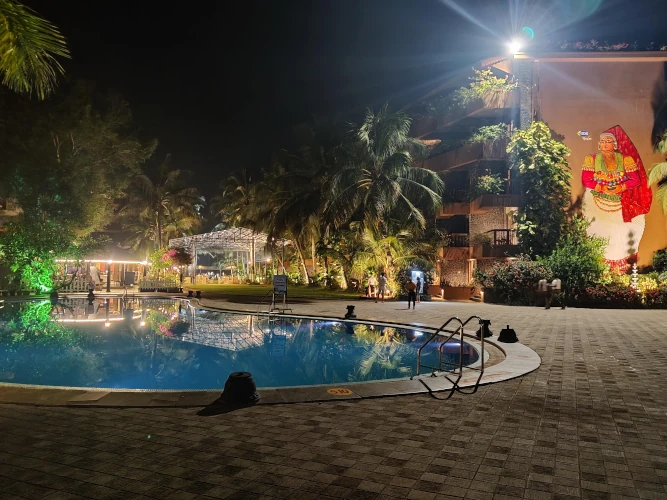 View At Night
View At Night -
Classical Dance Performance
Kanyakumari
Kanyakumari is the southernmost point of mainland India and famous for pilgrimage and its stunning views of the Arabian Sea, the Indian Ocean, and the Bay of Bengal which meets here. Well I heard that you could differentiate the seas by color at the confluence but I observed nothing of the sort. As we reached, first thing that caught our eye was Thiruvalluvar Statue. Sadly it was closed due to renovation work.
We visited Vivekananda Rock Memorial, ancient temple of goddess Kanyakumari and watched sunset on the beach.
Vivekananda Rock Memorial
As we reached we first visited the Vivekananda Rock Memorial, located on a small island off the coast of Kanyakumari. The memorial is dedicated to Swami Vivekananda, and is built on a rock that is said to be one of the most sacred places in India. It is said that he have attained enlightenment on the rock. According to legends, it was on this rock that Goddess Kanyakumari (Parvathi) performed tapas in devotion of lord Shiva.
The boat ride to the island was exciting, and the view of the ocean from the top of the memorial was breathtaking. A meditation hall known as Dhyana Mandapam is also attached to the memorial for visitors to meditate.
-
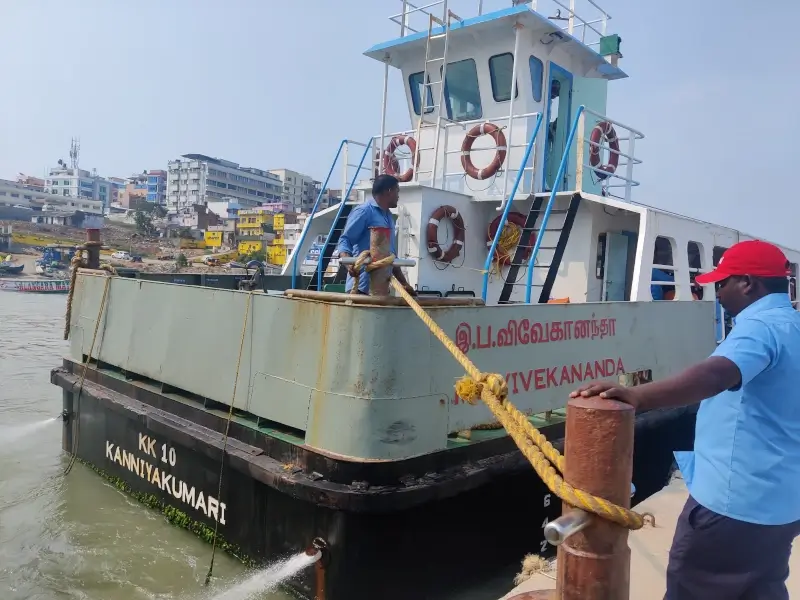 Taking a Ferry to the Memorial
Taking a Ferry to the Memorial -
 Vivekananda Rock Memorial
Vivekananda Rock Memorial -
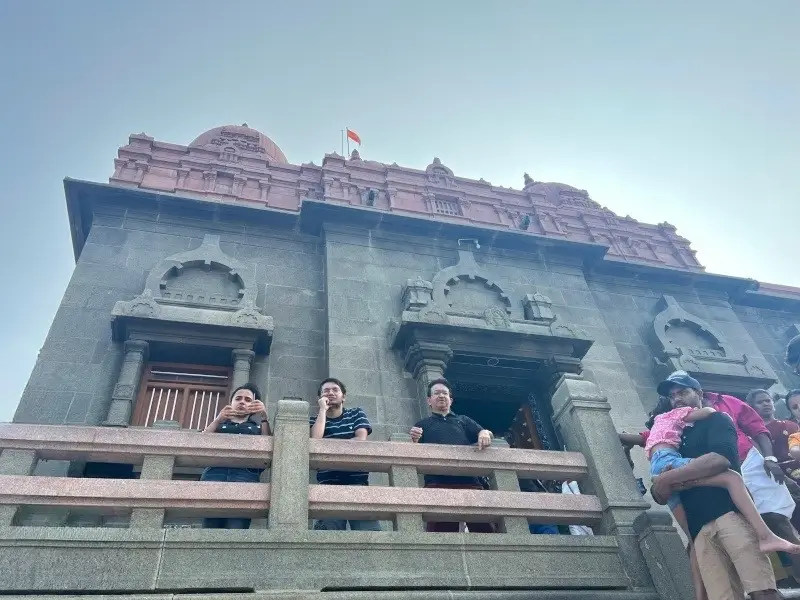 Hey Click a photo Na
Hey Click a photo Na -
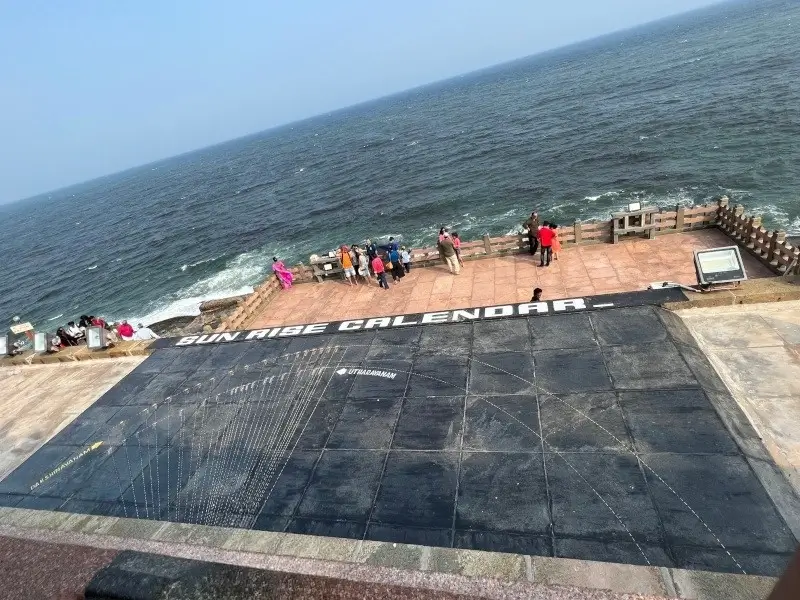 Sun Calendar
Sun Calendar -
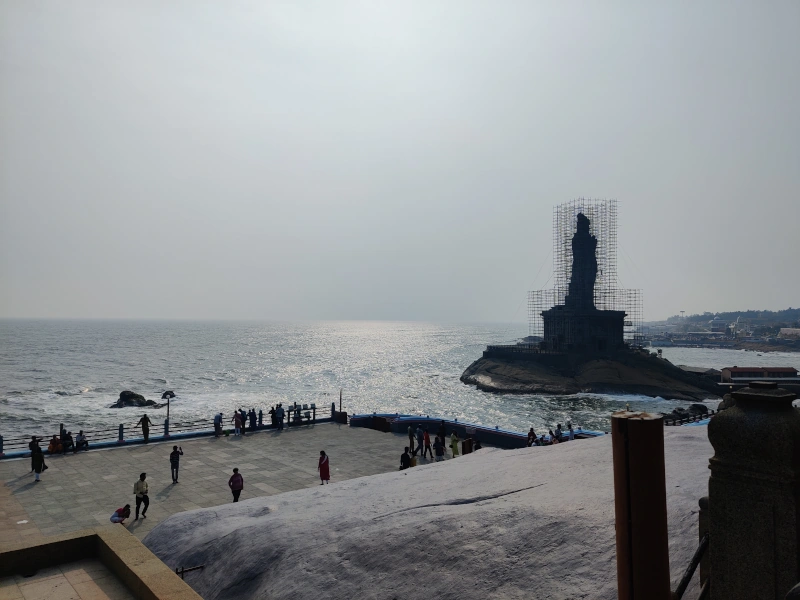 Thiruvalluvar Statue
Thiruvalluvar Statue
Beautiful Sunsets
As the sun sets, the sea becomes a golden mirror
In the evening we just sat on the beach to watch the sunset. The sky turned into a canvas of orange and pink hues, and the sound of the waves crashing against the shore was soothing.
-
 Watching Beautiful Sunset At A Beach
Watching Beautiful Sunset At A Beach -
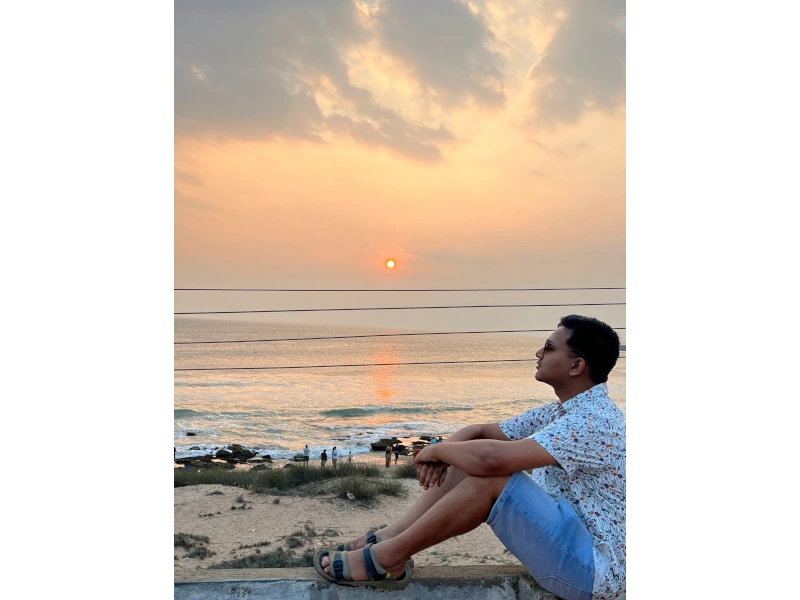 Sun on the Horizon
Sun on the Horizon
Visiting Kanyakumari has been an unforgettable experience especially the beaches and the sea. Anyways we left the place soon after sunset since we have get back to Trivandrum and leave early morning for Alleppey.
Alleppey
Alleppey, also known as the Venice of the East, is a picturesque town famous for its intricate network of canals and backwaters, and have earned it the comparison to the iconic Italian city of Venice. The lush greenery of the surrounding landscape provided a breathtaking backdrop to the shimmering waters of the canals.
House Boat
The highlight of our visit to Alleppey was undoubtedly the boat ride through the backwaters. The tranquil waters, surrounded by greenery and dotted with small villages and rice paddies, provided a sense of calm and contentment to our mind.
Our boat was designed in a traditional style, with a thatched roof and wooden interiors that create a warm and inviting atmosphere. It was equipped with all the modern amenities including comfortable beds, air conditioning, and private bathrooms. One of the most striking features of the boat was its spacious and airy decks, which offer panoramic views of the surrounding backwaters.
-
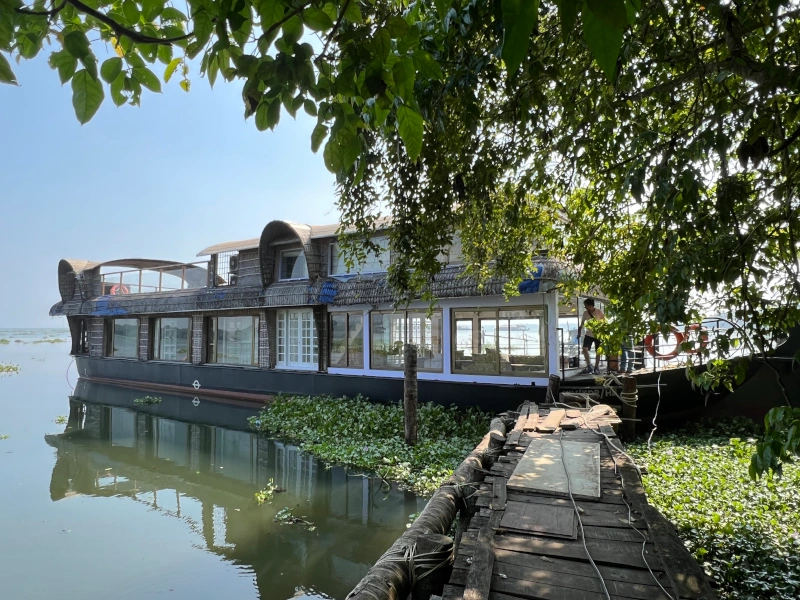 Our Ride
Our Ride -
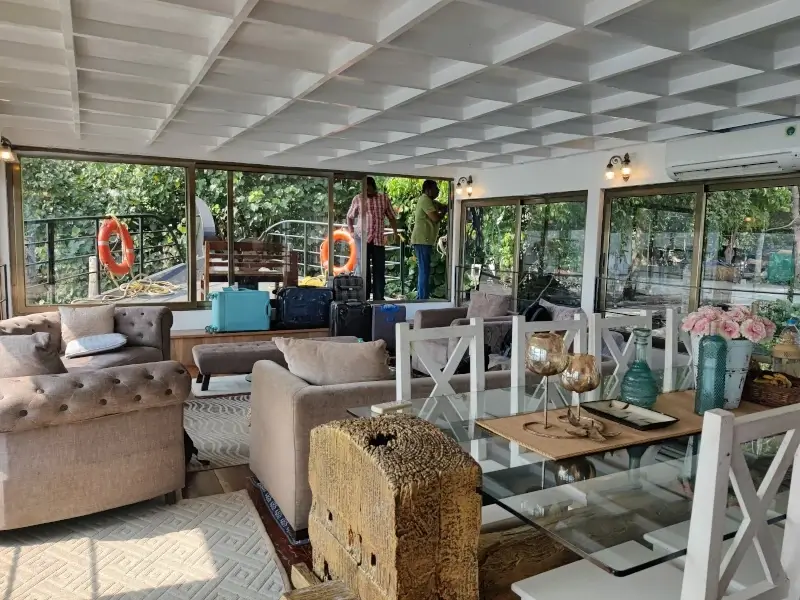 Sun on the Horizon
Sun on the Horizon -
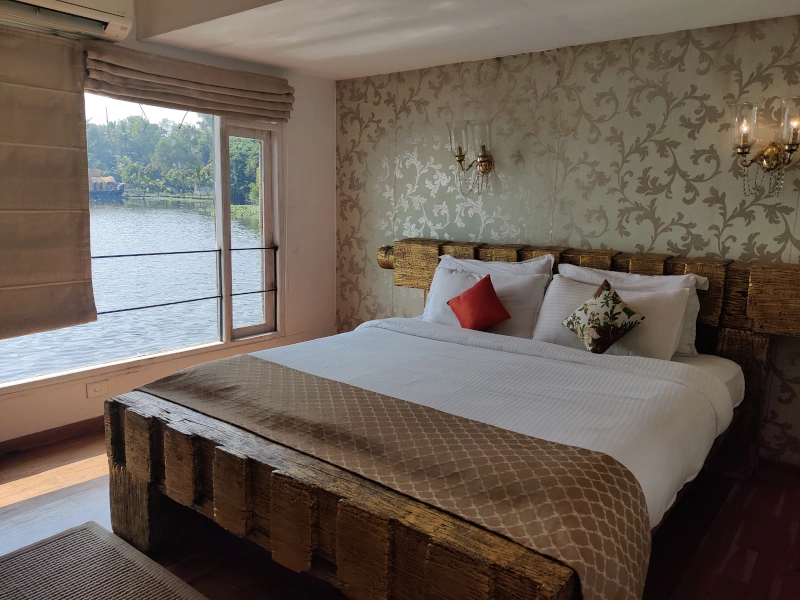 My Room!!
My Room!! -
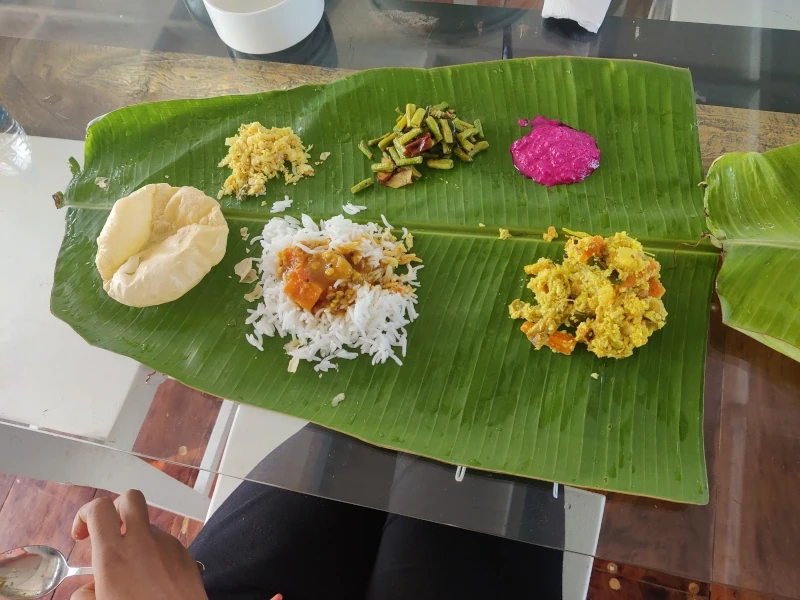 Authentic Kerala Lunch on Banana Leaf
Authentic Kerala Lunch on Banana Leaf
Once boat started moving we enjoyed authentic local cuisine (vegetarian only) on a banana leaf. After having lunch, we roamed around the house boat, took pictures, played cards and even got to ride the boat for a little while.
-
Ahoy Captain
-
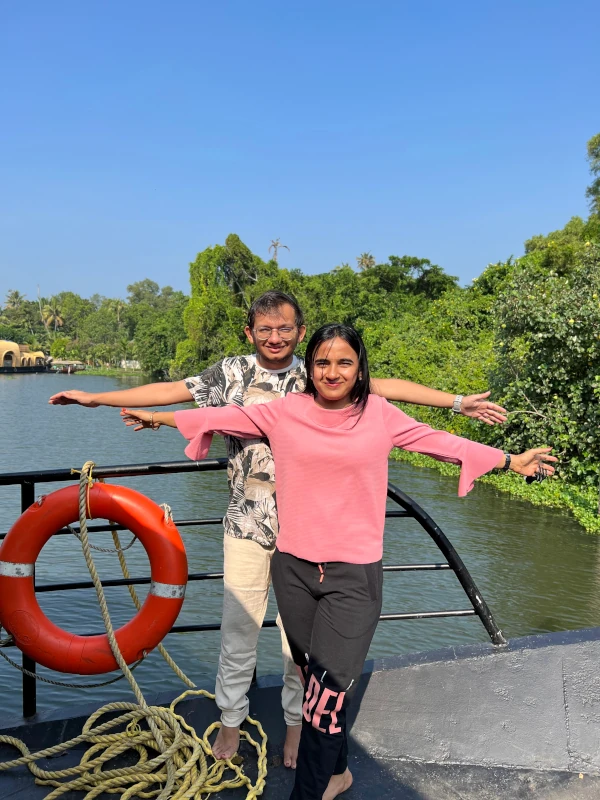 Fake Titanic Pose
Fake Titanic Pose -
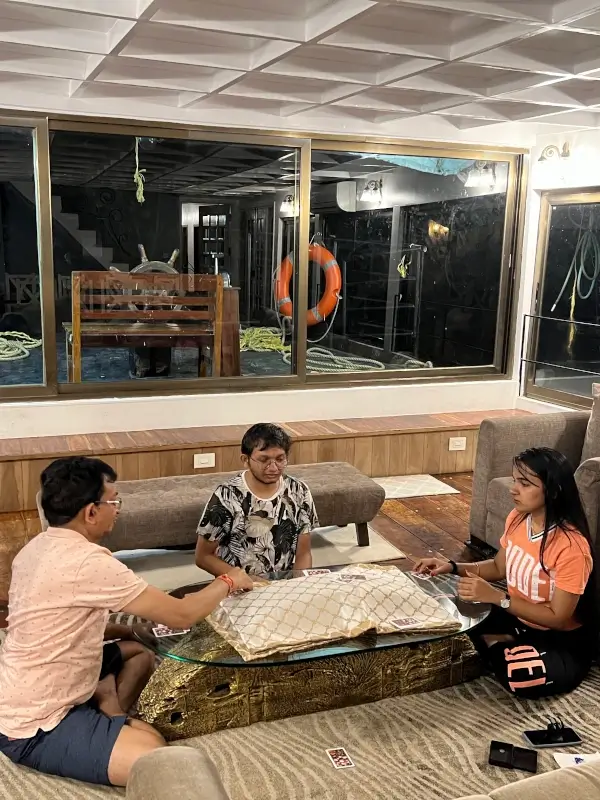 Playing Cards, I was winning
Playing Cards, I was winning
As the sun began to set, the colors of the sky reflected beautifully on the water, creating mixed hues of red, pink and orange. Then the stars came out, and we spent the evening stargazing and enjoying the peaceful atmosphere. Occasionally also served as a food for hungry and fat mosquitoes.
Anyways then we retired to our cozy cabins for the night. Next day we woke up early to watch the sunrise, had breakfast and waited for the boat to reach the docks. The houseboat is truly a unique way to experience the natural beauty of Kerala.
Kumarakom Bird Sanctuary
Visiting the sanctuary during the wrong season was a bit disappointing, as we didn't get to see any bird. However, we were still struck by the beauty of the place, and appreciated the beautiful and serene surroundings. We still enjoyed exploring the sanctuary's winding paths and taking in the scenery.
Munnar
Nestled amidst the Western Ghats, Munnar is a picturesque hill station that promises a refreshing escape from the hustle and bustle of city life. It is famous for its lush green tea plantations.
Cheeyappara & Valara Waterfalls
Along the way to munnar we saw Cheeyappara and Valara waterfalls. They were beautiful but nothing so different from hundreds of other waterfalls.
-
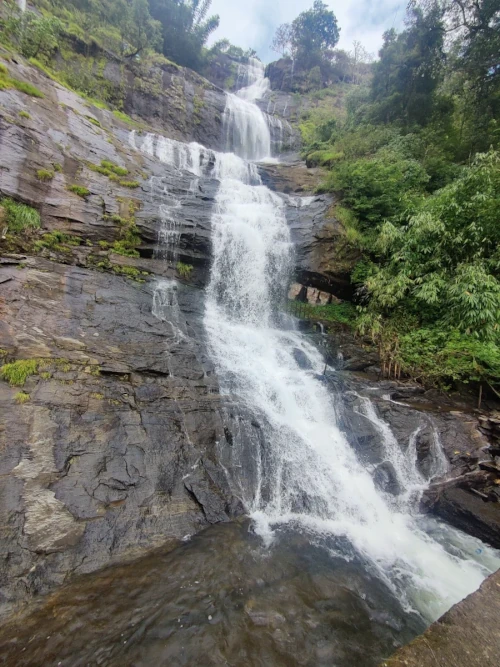 Cheeyapara Waterfall
Cheeyapara Waterfall -
 Valara Waterfall
Valara Waterfall
Spice Garden
Before reaching our hotel we also visited spice garden. The gardens themselves were a sight to behold, with a profusion of different plants and herbs growing in abundance. Our guide took us on a tour of the gardens, explaining the different varieties of spices and their medicinal properties.
Some on the herbs he showed us were - Cardamom, Sattavadi, Sanjeevani bati, Pancholi, Lemon grass, Stone banana, Torch lily, Chilly, Ashvgandha, etc. We also saw Cocoa fruit which is used to make chocolates. I learnt that day that ayurvedic medicines are not made from single herb but a mixture of 10-20 herbs in correct ratio.
-
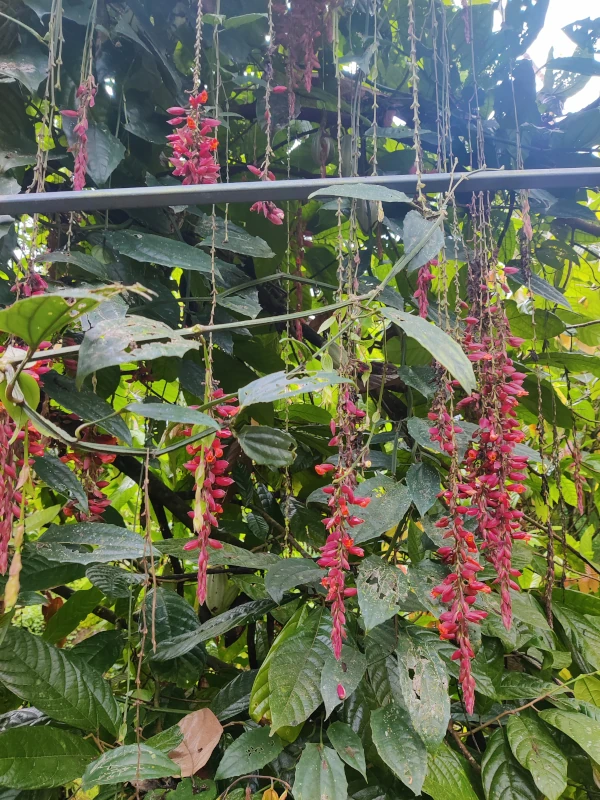
-
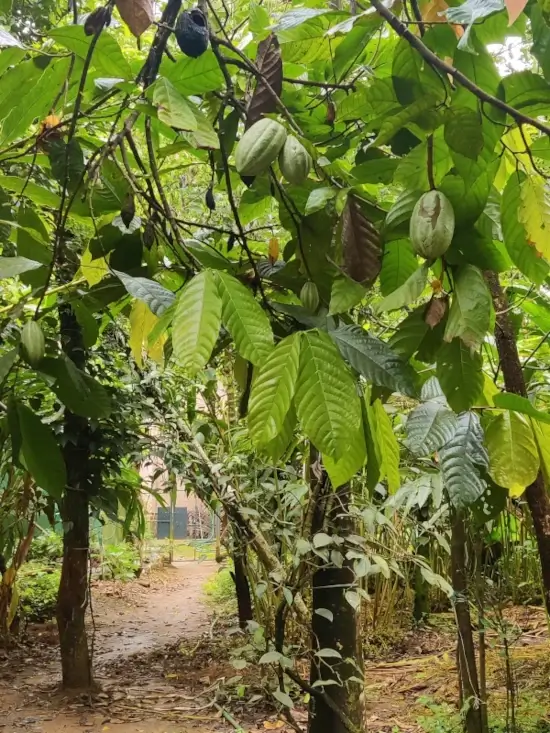 Cocoa Plant
Cocoa Plant -
 Cardamom Plant
Cardamom Plant -
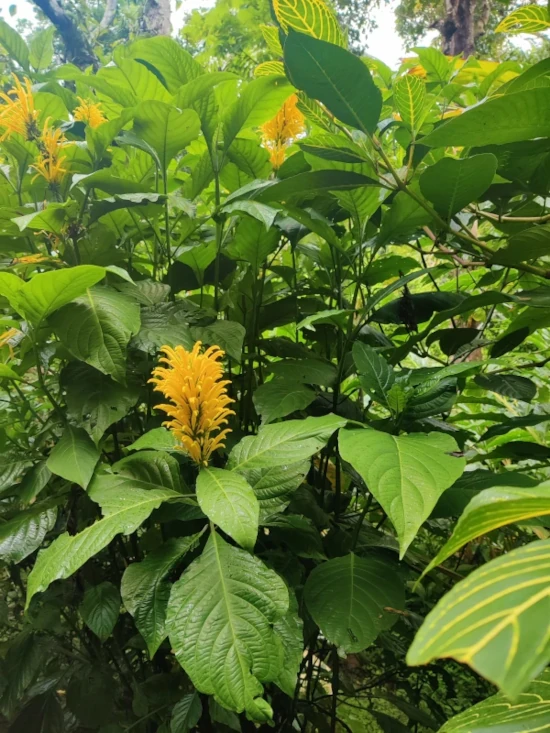
-
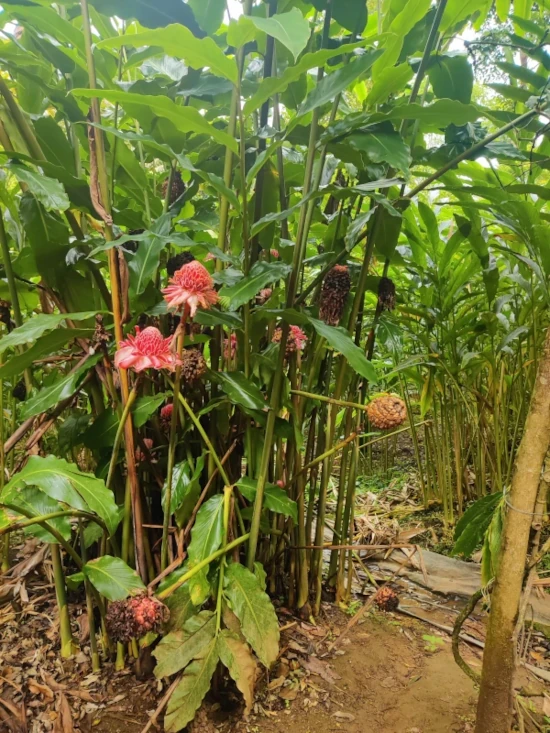
-
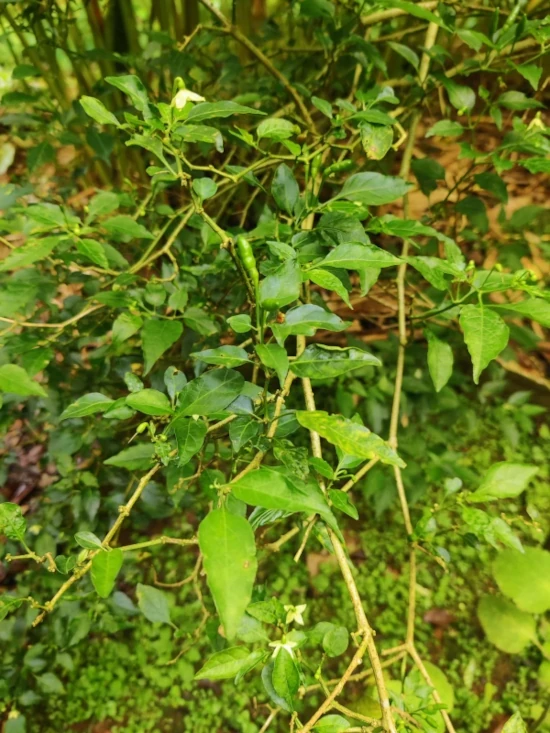 Green Chilly Plant
Green Chilly Plant
We also bought some coffee and medicines at the garden shop. Overall, our visit to the spice garden was very fascinating and educational that generated a new appreciation in me for the role of spices in our indian medicine.
Exploring our Hotel - Blanket Hotel & Spa
One of the things I loved most about the hotel was its location. It is set amidst the lush greenery of Munnar and offers breathtaking views of the surrounding hills and tea plantations.
Our room was spacious with stunning view of valley and waterfall. It even had infinity pool with breathtaking view of the hills. The dining options were equally impressive, with a range of delicious dishes on offer. We even went for morning yoga sessions. Overall we really enjoyed our stay in the hotel.
-
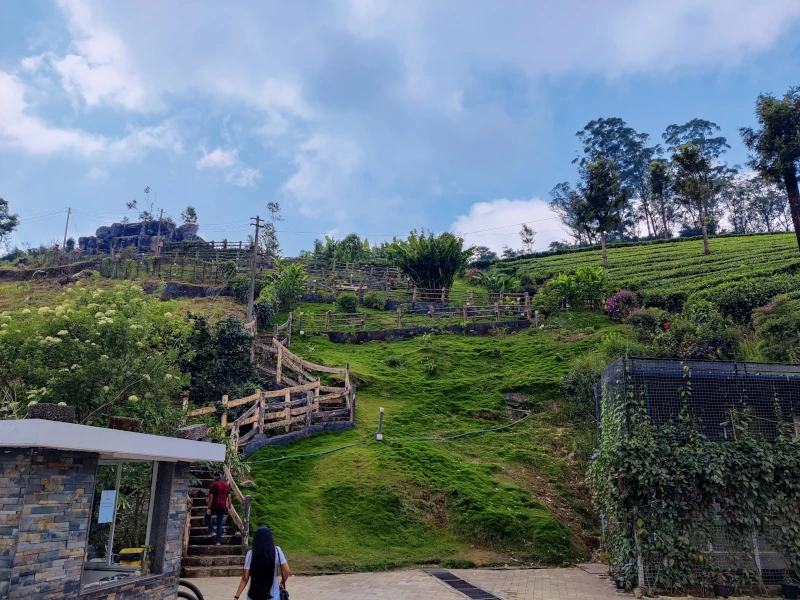 Hotel Entrance View
Hotel Entrance View -
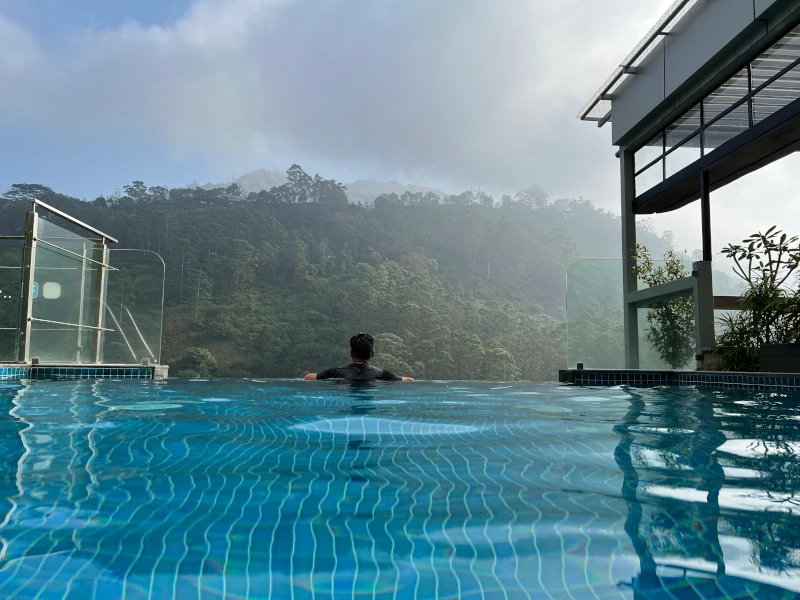 Infinity Pool!!
Infinity Pool!! -
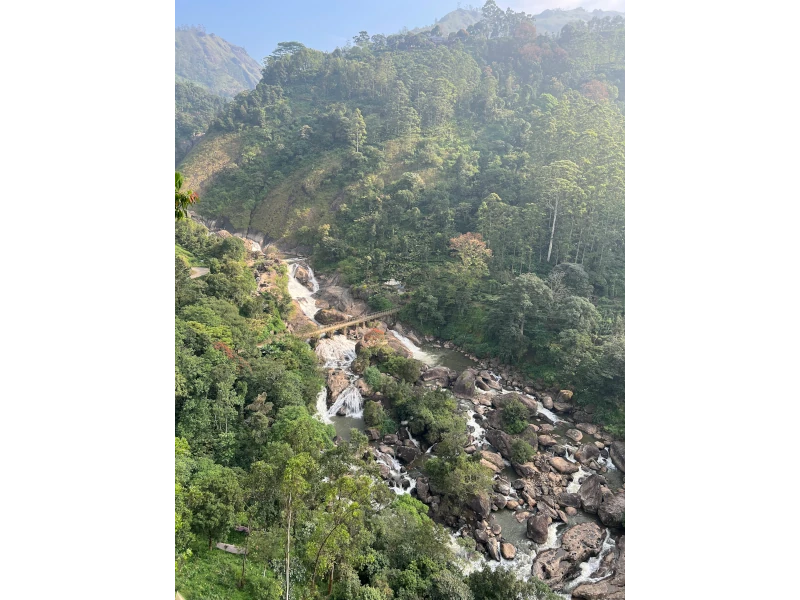 View from Our Room
View from Our Room
Visit to Chocolate factory
Next morning we started our tour with a visit to a chocolate factory. As we entered the factory, we were greeted by the sweet aroma of chocolate. Then, we were taken through the various stages of chocolate production, from roasting the cocoa beans to grinding them into a fine paste and then adding sugar and other ingredients to create the final product2 i.e the chocolate that we eat.
Towards the end of the tour, we were allowed to taste some of the delicious chocolates made on the premises. There were several varieties to choose from, including dark chocolate, milk chocolate, and flavored chocolates. We also brought lot of chocolates to take them home for ourselves as wells as to distribute to family and friends.
-
 Ripe Cocoa Fruit
Ripe Cocoa Fruit -
Processing Cocoa To make Chocolate
-
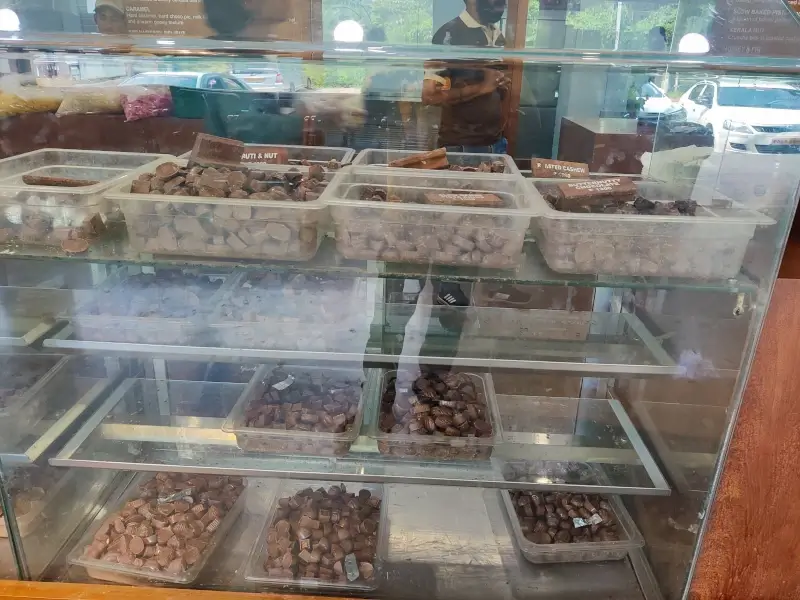 Lots of Options to Choose From
Lots of Options to Choose From
Jeep Safari
Next we went for jeep safari which took us through some of the most scenic and picturesque landscapes of the Western Ghats. Our journey started with a visit to the lush green Tea plantations. Next we went to ripple water falls. Even though we have to climb set of steps and areas over rocks to get to the falls, it was worth it. Our next stop was Hanging bridge that offered a bird's eye view of the surrounding valleys and hills.
After that we went to Mattupetty Dam which is the biggest dam in kerala. The dam is surrounded by lush green forests and offers breathtaking views of the hills and valleys.
The final leg of our safari took us to the high point, a vantage point that offered panoramic views of the surrounding mountains and valleys. It is said that you can almost see whole of the Malabar coast. The view from the top was breathtaking, and we spent some time taking in the beauty and pictures of the place.
-
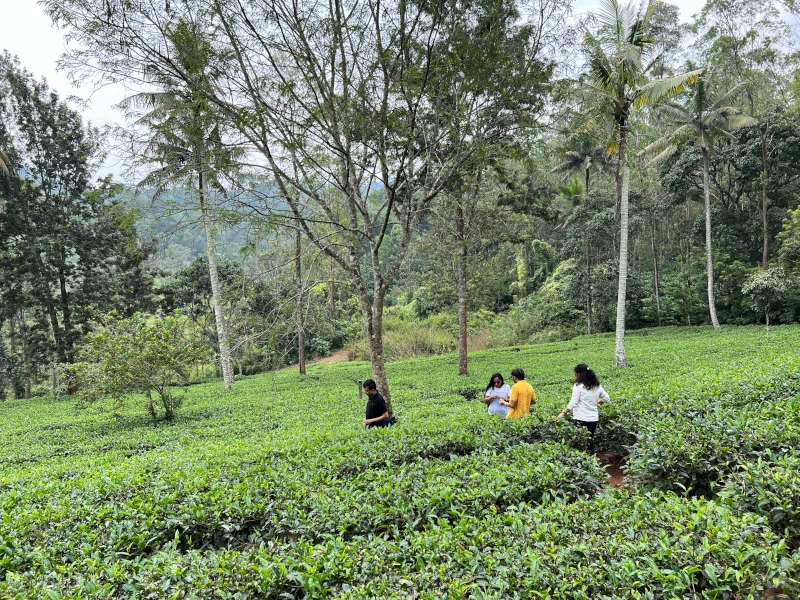 Visiting Tea Gardens
Visiting Tea Gardens -
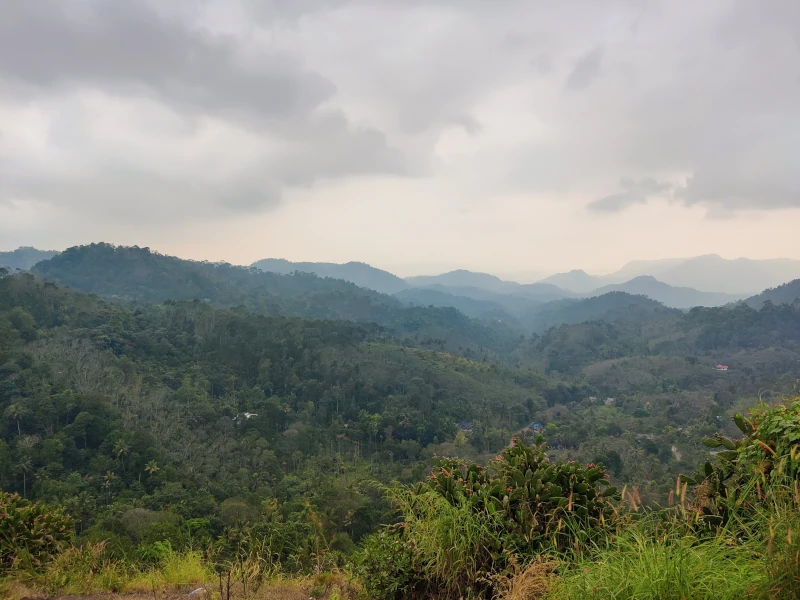 Highest Point In Munnar
Highest Point In Munnar -
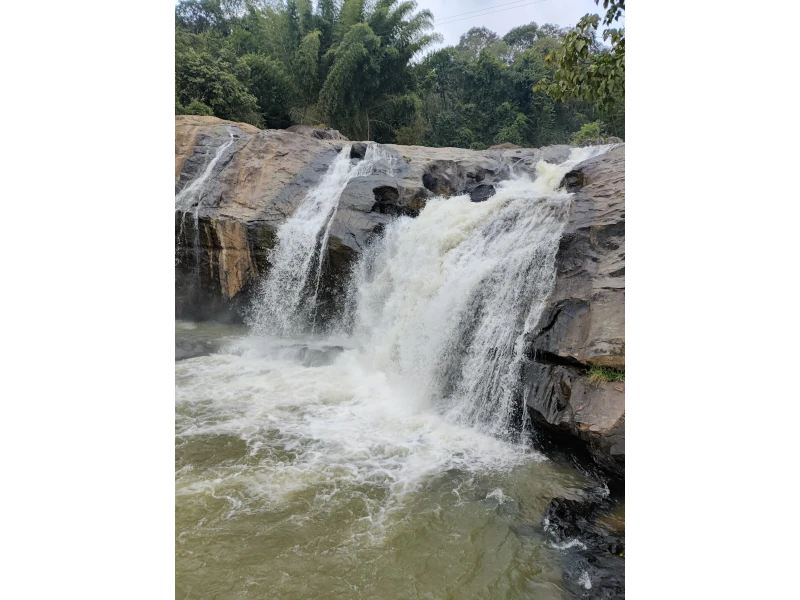 Ripple Waterfalls
Ripple Waterfalls -
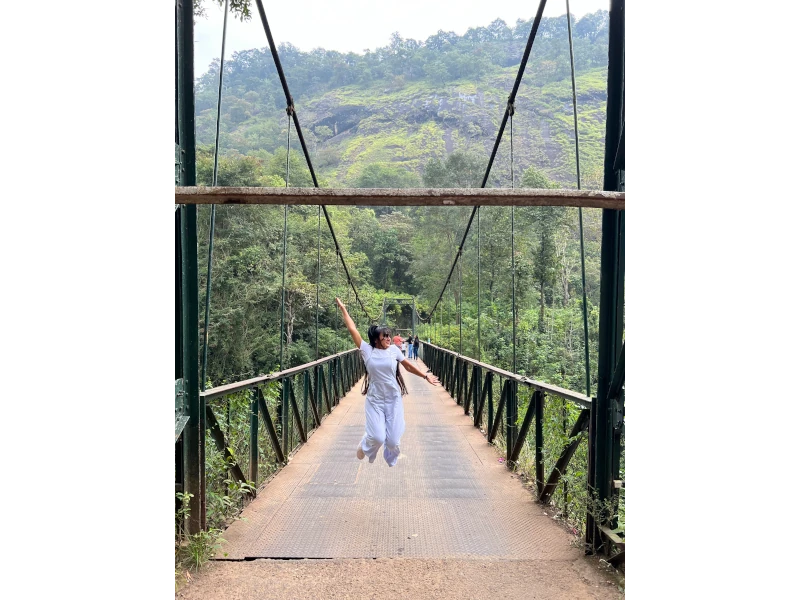 Hanging Bridge
Hanging Bridge -
 Mattupetty Dam
Mattupetty Dam
Soon after it started raining so we took shelter in a nearby shop and had maggie and coffee. Then we proceeded for the next part of our tour i.e an evening of immersion in Kerala's rich culture and heritage.
Cultural Shows
Kerala has a unique and diverse cultural history that is reflected in its art, music, dance, and architecture. They provide a glimpse into the daily life of the people, their beliefs, customs, and traditions, which helps to foster a greater understanding and appreciation of the local culture.
Cultural Dance
We witnessed a variety of dances, including Mohiniyattam, Kathakali, and Theyyam, each with its own unique costumes, makeup, and music. Mohiniyattam is a classical dance form that originated in Kerala and is known for its graceful and delicate movements. Kathakali is a more dramatic form of dance that involves elaborate makeup and costumes, with performers telling stories through facial expressions and gestures. Theyyam is a vibrant and colorful form of dance that is performed in the temples of Kerala, with dancers donning elaborate costumes and masks.
Throughout the performance, the dancers are accompanied by live music, with the sound of drums, cymbals, and other instruments filling the air. The combination of music, dance, and storytelling creates a mesmerizing and immersive experience that transports you to a different time and place.
Kalaripayattu
Then we saw Kalaripayattu, a martial art that originated in Kerala. The performers showcased their agility and skill with various weapons such as swords, shields, and spears. The fast-paced movements and acrobatic feats are accompanied by the sound of drum beats and cymbals, creating a dramatic and energetic atmosphere.
With this our day got concluded and we went to to hotel for the night. Next morning we had to to leave for Eravikulam National Park.
Eravikulam National Park
Eravikulam National Park is one of the major highlights of the visit to Munnar. As we entered the park, we were greeted by the lush greenery of the tea plantations that surrounded the park. The highlight of the park is the trek to Anamudi, the highest peak in South India.
To reach the Anamudi peak, we first need to go to halfway point via a bus ride. The waiting time of the bus was too long, it almost took us an hour to reach our turn. The park is home to a variety of flora and fauna, including several endangered species such as the Nilgiri Tahr. We were lucky enough to spot one grazing on the roadside during the ride.
Once we reached the halfway point, we started the trek to the peak. The trail trail winds its way through the park, passing through grasslands and forests, and offering breathtaking views of the mountains and valleys. As we neared the peak, the terrain becomes steeper and more challenging, but the view was worth the effort. From the top, we were able to see the entire park spread out before us, though the visibility was low because of the fog.
-
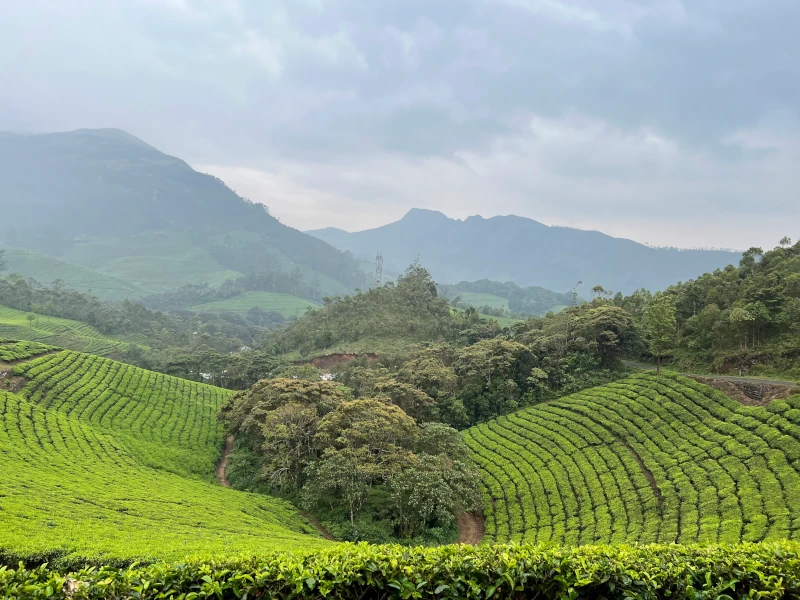 Inside Eravikulam National Park
Inside Eravikulam National Park -
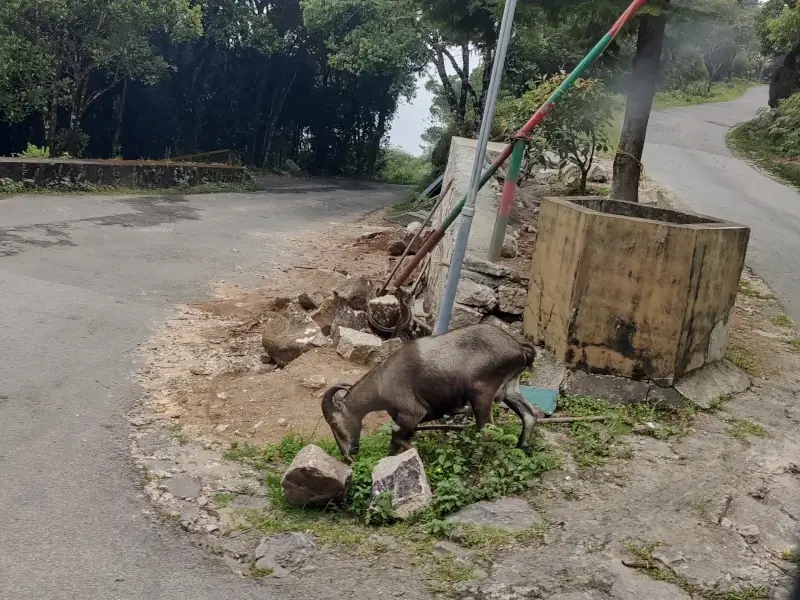 We saw Nilgiri Tahr
We saw Nilgiri Tahr -
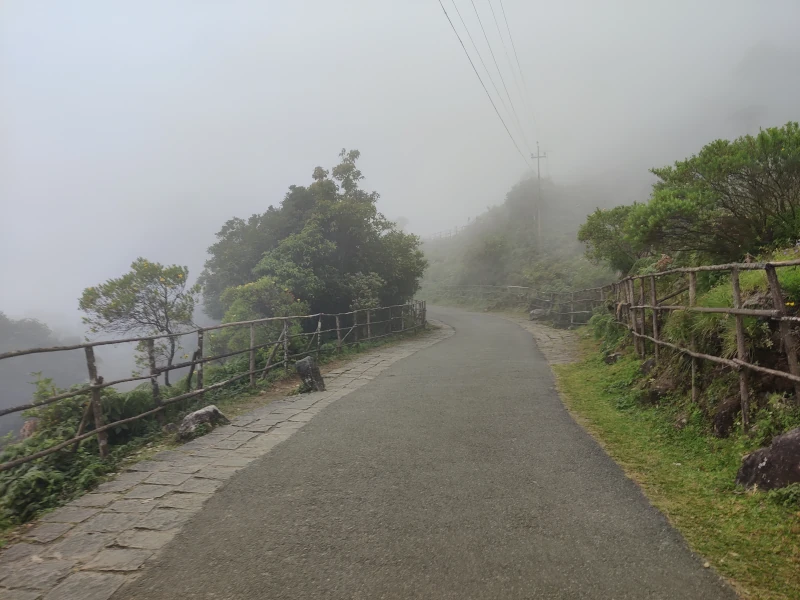 Foggy Trail
Foggy Trail -
 Near Amanundi Peak
Near Amanundi Peak -
 Click a photo na
Click a photo na
Overall I can confidently say that it is a must for nature lovers and adventure enthusiasts, offering a unique experience of the natural beauty of Munnar.
Kannan Devan Tea Museum
Kannan Devan Tea Museum also famously called Tata Tea Museum is housed in a beautifully restored colonial-era tea factory. The plantation surrounding it dates back to the 1880s. The museum houses various exhibits and displays that showcase the history and evolution of tea production in the region. Apart from that it also display's colonial era telephone exchanges, old typewriters, etc.
We were expecting a proper explanation of tea processing from tea leaves but there was no one available. The machines were also not working. They had a tea store inside and that is where they just ushered the visitors. No tea tasting was available. Anyways we felt that, this visit could have been better.
-
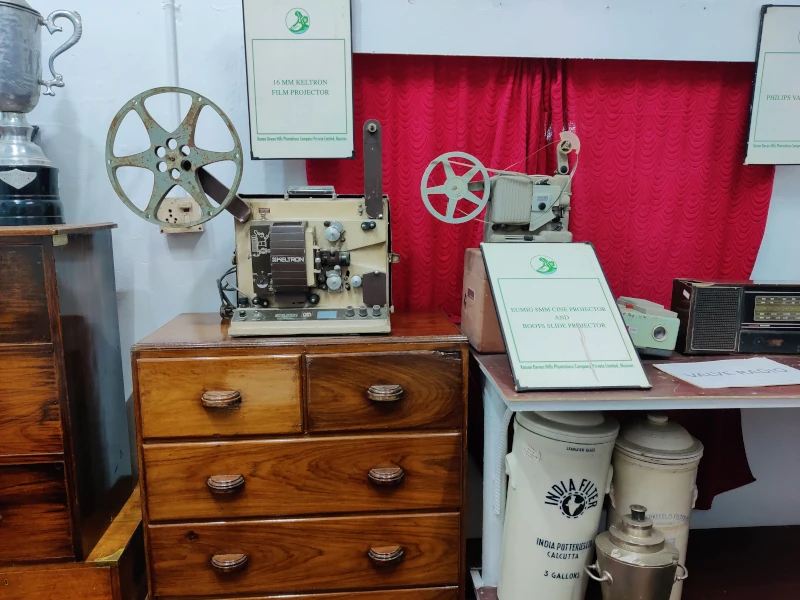 Old Film Projector
Old Film Projector -
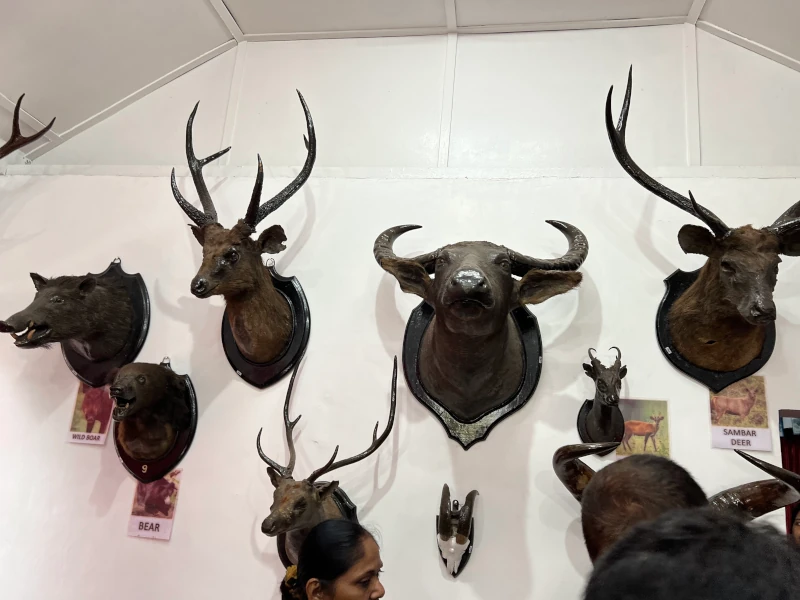 Taxidermy
Taxidermy -
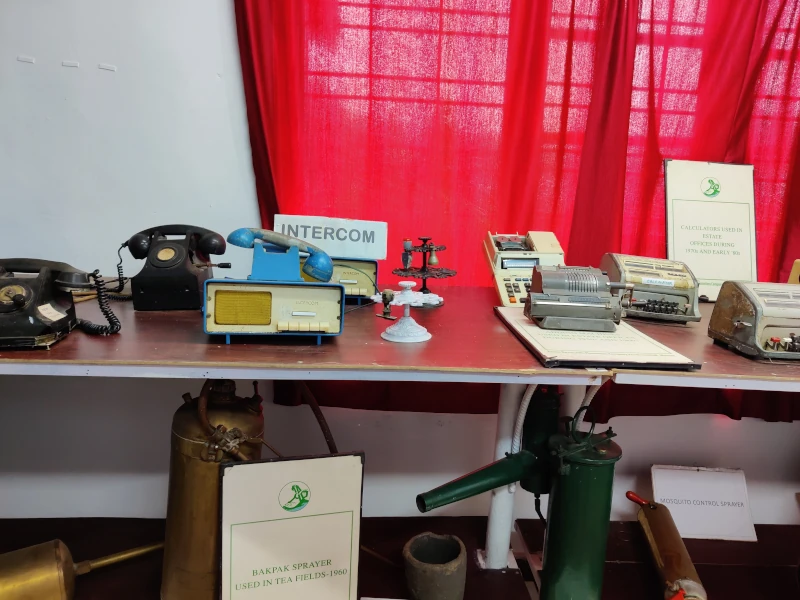 Old Telephones
Old Telephones
Kundala Arch Dam
Kundala Dam is Asia’s first arch dam3. The dam is an impressive feat of engineering, with its curved arch structure spanning the valley and holding back the waters of the Kundala Lake. Nearby, we also visted the Echo Point, where we were easily able to reverberate our voice across the valley.
-
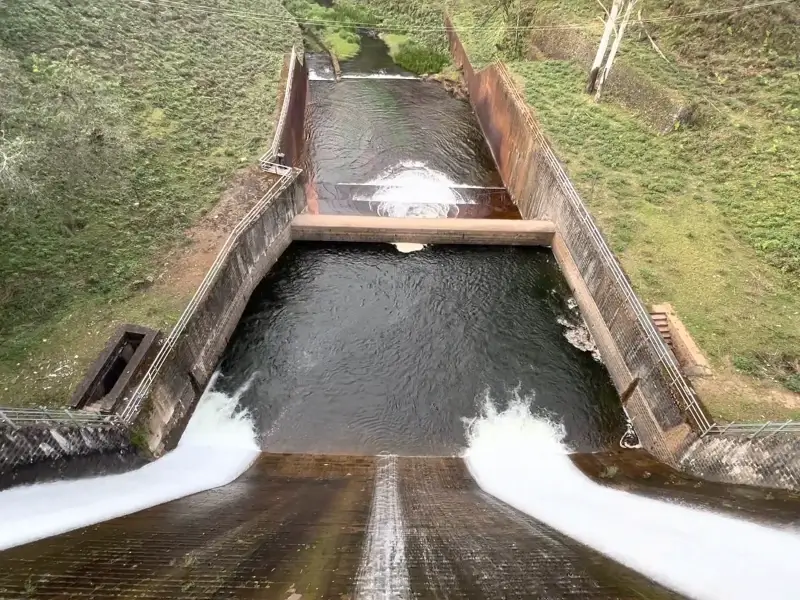 Kundala Dam
Kundala Dam
This marked the end of second day in munnar. We left for hotel since it was getting dark.
Elephant Ride
Next day was our last day in Kerala. We checked out from the hotel and went for the Elephant ride. It was a shorter ride than expected. We learnt that you can do proper elephant safari in Thekkady town near Periyar National Park.
-
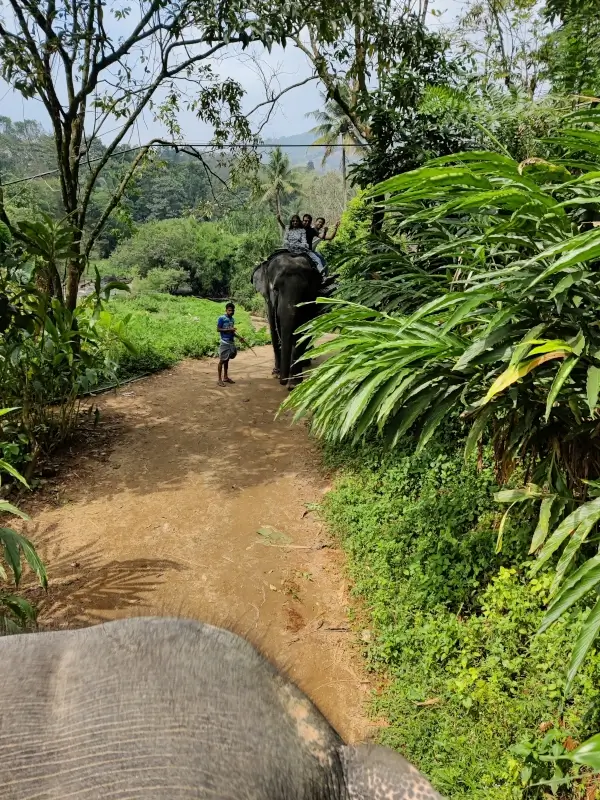 Elephant Ride
Elephant Ride -
Garland Ritual
End Of Trip
As we came to the end of our journey through Kerala, it was hard to put into words the beauty and diversity that we have experienced. We will carry these memories with us as we journey back home, and hope to one day return to this beautiful land of palm trees, spice markets, and picturesque backwaters again.
Thank you, Kerala, for an unforgettable experience.
